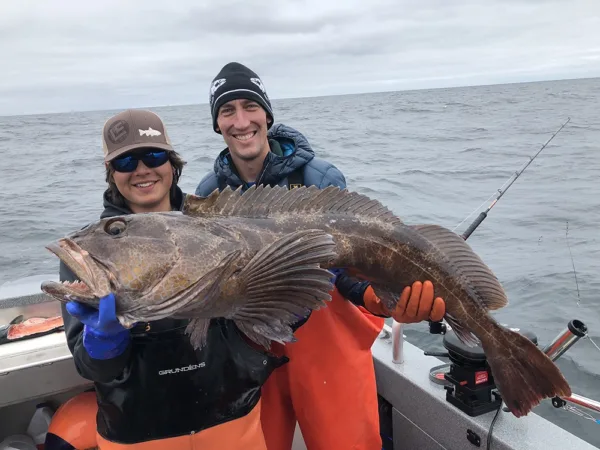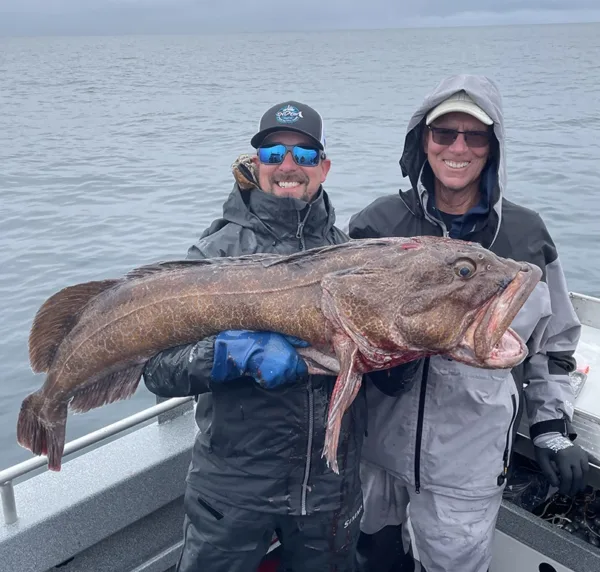Alaska lingcod fishing is simply phenomenal.
 Lingcod are managed conservatively, and the result is a bountiful population and some very large specimens. Lingcod aren’t as avidly pursued as salmon and halibut in Sitka, but they are a sinister, apex predator that will attack any fish they think they can swallow. Despite the unpleasant demeanor and an appearance only a mother could love, Alaska lingcod have moist, white flesh that many prefer over halibut.
Lingcod are managed conservatively, and the result is a bountiful population and some very large specimens. Lingcod aren’t as avidly pursued as salmon and halibut in Sitka, but they are a sinister, apex predator that will attack any fish they think they can swallow. Despite the unpleasant demeanor and an appearance only a mother could love, Alaska lingcod have moist, white flesh that many prefer over halibut.
Sitka has ideal lingcod habitat, as well as habitat for many species of rockfish. The shorelines are nearly all rocky, and a quick look at a bathymetric chart will show underwater pinnacles are all over the sea floor. A day spent chasing lings and rockfish can result in many meals’ worth of delicate white fillets.
The current Sitka lingcod regulations came from a May 2021 Emergency Order. They could change again by 2022, so be sure to check the regulations and the Emergency Orders on the Alaska Department of Fish and Game (ADF&G) website before you fish for Alaska lingcod.
 Alaska rockfish species are divided into three categories for regulatory purposes: Pelagic Rockfish, Slope Nonpelagic Rockfish, and Demersal Shelf Rockfish.
Alaska rockfish species are divided into three categories for regulatory purposes: Pelagic Rockfish, Slope Nonpelagic Rockfish, and Demersal Shelf Rockfish.
Pelagic Rockfish include Black, Blue, Dark, Dusky, Widow and Yellowtail rockfish. They are relatively fast growing, numerous, and tend to move around rather than live on one rockpile their entire lives. Because of this, Sitka anglers are allowed to keep three pelagic rockfish daily of any size. These are the fish to target for your next several batches of fish tacos.
Slope Nonpelagic Rockfish include Blackgill, Blackspotted, Bocaccio, Brown, Chilipepper, Darkblotched, Greenstriped, Harlequin, Northern, Pacific Ocean Perch, Puget Sound, Pygmy, Redstripe, Redbanded, Rougheye, Sharpchin, Shortbelly, Shortraker, Silvergray, Splitnose, Stripetail, Vermilion, and Yellowmouth rockfish. The daily limit on these species is one fish per day of any size. If you think you want to target Slope nonpelagics, you’ll want to study, very carefully, rockfish identification characteristics as many rockfish species look very similar.
Demersal Shelf Rockfish include Canary, China, Copper, Quillback, Rosethorn, Tiger and Yelloweye rockfish. None of these may be harvested as they are very slow-growing, long-lived fish that often live on the same rockpile their entire lives (which could be as much as 60 years) which makes them extremely vulnerable to overfishing.
Alaska state regulations require anglers fishing for bottomfish to have onboard a descending device (Shelton’s SFD, Seaqualizer, Rocklees) and to descend rockfish that are not legal to keep or not desired back down to the depth of capture or 100 feet, whichever is shallower. Note that a large yelloweye rockfish may require up to five pounds of weight to successfully descend it.
 Alaska lingcod are most often caught on jigs. Lead-head jigs from four to 12 ounces, with an appropriately sized curly-tail grub account for a lot of lings. Large swimbaits work, too. They can also be suckers for metal such as Ahi Live Deception jigs, Point Wilson Darts, Viking jigs and even homemade pipe jigs. The Kodiak Customs Halibut Jig and the Daiwa Rock Rover have also proven themselves.
Alaska lingcod are most often caught on jigs. Lead-head jigs from four to 12 ounces, with an appropriately sized curly-tail grub account for a lot of lings. Large swimbaits work, too. They can also be suckers for metal such as Ahi Live Deception jigs, Point Wilson Darts, Viking jigs and even homemade pipe jigs. The Kodiak Customs Halibut Jig and the Daiwa Rock Rover have also proven themselves.
Although Alaska lingcod are fools for jigs, bait accounts for fish as well. Halibut anglers fishing hard-bottomed areas often have lings grab their baits. However, a large chunk of herring on a circle hook isn’t the most effective bait for lings. The most effective bait is probably a live greenling, which are legal to use as bait in Alaska. Use a spreader bar, with enough weight attached to the short end to take the greenling down. Use a heavy mono leader (80-pound-test or more) or a steel leader to which two 9/0 Octopus hooks are snelled. Hook the greenling through the lips with the top hook and insert the trailing hook under the dorsal fin. Lower it to the bottom, bring it up a few feet and wait. It won’t take long if you’re on good ling structure. Note that it is not legal to use any fish for which there is a bag limit as bait. That means you can’t use rockfish, and if a ling grabs onto a rockfish you have hooked, you’re required to release that ling.
Alaska lingcod are tough, and they don’t have a swim bladder, so they generally are able to swim back down to the bottom if released.
The Sitka area’s kelp-lined shorelines abound with both pelagic and nonpelagic rockfish, and even lings. Using light tackle (think bass fishing gear or perhaps steelhead gear), anglers fish light jigs for rockfish and can usually land their three pelagic rockfish in as many casts, once they’ve located a school (yes, pelagic rockfish often form loose schools).
After a day’s halibut or salmon angling, or perhaps on a bad-weather day where it’s not possible to go outside Sitka Sound, it’s relatively easy to fish shallow along protected shorelines for your three pelagic rockfish, perhaps catching a few greenling in the process. Then you can move to deeper pinnacles and rockpiles to jig larger lures or drop live greenling down for ferocious-looking lings.
No matter if you do it at the beginning of the day or the end, Alaska lingcod and rockfish round out the fish box with something different but equally as delicious as salmon or halibut.